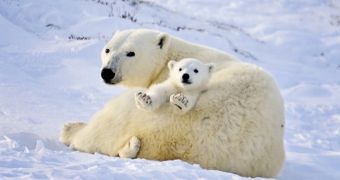A recent study has found that the Arctic's Svalbard islands are beginning to run low on cute, furry bundles of joy commonly referred to as polar bear cubs, and that man-made climate change and global warming might just be the ones to blame.
The Guardian tells us that, each year, scientists with the Norwegian Polar Institute try to figure out how many of the polar bear females living in this part of the world have embraced a career as mothers.
This April, researchers found that, out of a total of 29 adult females tracked and monitored, just 3 were accompanied by a cub at the time they left their dens, the same source details.
Specialists explain that, all things considered, this indicates that the percentage of lady polar bears delivering cubs in the Arctic islands of Svalbard has crashed to just 10% of the overall population.
“This is a lower number than we would have expected,” researcher Jon Aars with the Norwegian Polar Institute comments on the findings of this survey in a recent interview with the press.
To put things into perspective, it need be said that, back in the 1990s, about 50% of the polar bear females living in this part of the Arctic would become pregnant and successfully deliver cubs.
Specialists are yet to confirm this, but evidence indicates that this drop in the number of polar bear cubs born to females in the Arctic's Svalbard archipelago is due to environmental changes brought about by rising temperatures and melting sea ice.
Thus, it could be that female polar bears are having trouble deciding to become mothers due to the fact that, since global warming is gradually reducing the local sea ice coverage, hunting seals, which are their main food source, has become a rather tricky job.
“Maybe this [year's low number] was because we have had mild years recently with worse ice conditions or maybe it was just a bad year,” Norwegian Polar Institute researcher Jon Aars says in a statement.
“It is alarming but it is quite a small sample, so we have to be careful. But if this is something that repeats itself in coming years then it will be a concern,” the specialist wishes to stress.
Studies have shown that, in 2014, winter ice coverage in the Arctic dropped to its fifth-lowest extent ever documented. As climate change and global warming progress, researchers expect that things will take a turn for the worse and that the local polar bear population will sooner or later be affected.
As Jon Aars put it, “With worse and worse sea ice conditions we think there will come a point when the population will suffer, but we don't know when that point is.”

 14 DAY TRIAL //
14 DAY TRIAL //